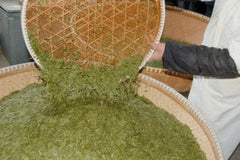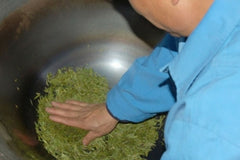Dragon Well (Long Jing) - green tea
Sold Out

| Style | Green Tea | |
| Origin | Da Fo Village, Xin Chang County, Zhejiang, China | |
| Season | March Harvest | |
| Altitude | 400m | |
| Batch | SCLJ1 | |
| Plant | Jiu Keng cultivar | |
| Tea Master | Master Wei |
One of China’s most renowned teas. The distinctive flat leaf is pan-fired by hand in a dry wok, giving gorgeous chestnut, hazelnut and light floral characters. An authentic Long Jing with exceptional provenance is an essential part of any tea connoisseurs’ collection and is an excellent introduction to exploring Chinese green tea. No chemical fertiliser, pesticide, or herbicide was used in the production of this tea.

The Stories We Drink
|
In the west, this tea goes by a number of names including Dragon Well, Long Jin or Lung Ching. It’s China’s national tea and is, without doubt, one of the most famous green teas in the world. Treasured by emperors and wealthy connoisseurs since 750AD, if you’re a foreign dignitary or VIP visiting China, this is the tea you will be served. Dragon Well’s flattened leaves, strong aroma and deep, long-lasting flavour is distinctive. The yellower the leaves the better, indicating less chlorophyll and younger buds which is a desirable trait for this style of tea. A truly authentic Long Jing comes from the small area of Hangzhou (West Lake) in the Zhejiang region and commands exceptionally high prices - upwards of $4000 per kilogram. Many argue that Long Jing is still authentic if it comes from within the broader Zhejiang province, and indeed there are a handful of excellent Long Jing tea masters and gardens that sit right near the West Lake area who produce excellent examples of Long Jing. The terroir is similar but the prices are more affordable because the land sits outside the most conservative authentic boundary. Our Long Jing comes from an outstanding garden in Da Fo village which is outside the Hangzhou boundary but within the Zhejiang province boundary and is therefore still a reasonably authentic high grade example. Master Wei is a very experienced tea master who overseas growing, harvesting and intricate processing. Authenticity of provenance is important with Long Jing since it is so widely produced across China in areas like Yunnan, Guizhou, Sichuan, and Guangdon. These regions produce Long Jing with quite different characteristics and are often marketed to unsuspecting buyers as the real deal. Many tea merchants turn a blind eye and continue the dishonesty, while others simply don’t understand or know the difference in origin. This is why there are so many low grade versions of Long Jing that flood the export market, and this means you end up paying authentic Long Jing prices for a lower quality product. It’s important you know which part of the country your Long Jing comes from. For the best flavour, characteristics and drinking experience we suggest you stick to examples from the Zhejiang province region. |
|
Craftsmanship
Master Wei hand processes his Long Jing which takes plenty of skill perfected over many years. Many of the most outstanding Long Jings are made by older tea masters with great depth of experience thanks to the complexity of the hand roasting phase.
 |
Plucking: the leaves are plucked by hand early in the spring when the tea buds are about 1.2cm tall. The picking standard is a single bud with one or two tender leaves. | |
 |
Sorting: The leaves are inspected and sorted to make sure the quality is suitable. | |
 |
Withering: Master Wei places the plucked buds on bamboo trays and lets them wither for two hours. This reduces the water content in the leaf and makes the buds soft in preparation for frying. |
|
 |
Firing: the buds are fired at around 200 degrees Celsius for between three and four minutes and this stops the oxidisation of the leaf. Master Wei lets the leaves rest for a while and prepares the pan frying area. | |
 |
Roasting: Master Wei prepares a wok and heats it to between 70 and 90 degrees Celsius. The leaves are hand fried for around 15 minutes. This is the true test of skill for a tea master and Master Wei uses specific movements with his bare hands to fry the leaf and give the tea its signature flat shape. His hands must be bare so he can feel the temperature of the work and the delicate changes in the leaf throughout the process. The tea is processed in very small batches, generally about 100 grams at a time. Generally tea masters on process about a kilogram in total each day. You can understand why mass-produced Long Jing loses some of the associated craftsmanship. It’s simply not viable to do it all by hand. He leaves the tea for a few hours and repeats the process but at a lower temperature and for a little longer. It’s vital the temperature is carefully controlled so the leaf doesn’t burn. Master Wei needs the correct pressure and hand movements too. If he makes a mistake, the leaves become too dark in colour or become the wrong shape which results in a much lower grade of tea. |



















